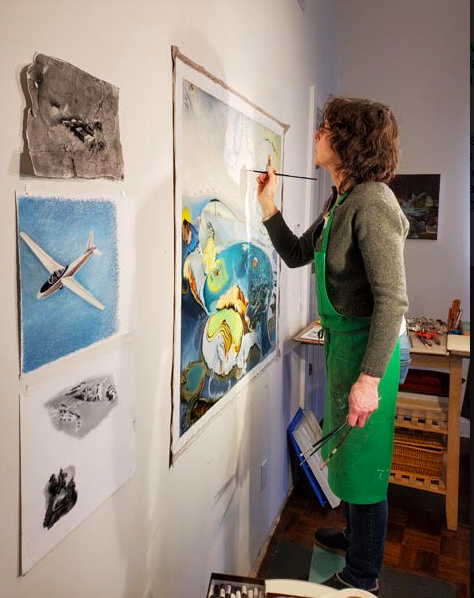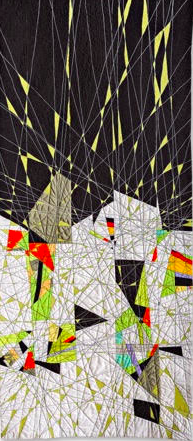Cost $10 per visit
Rockland Center for the Arts (RoCA) continues its mission of enrichment through the arts. RoCA will present artists’ studios tours: LIVE and interactive! This summer you’ll get the rare privilege of stepping into some incredible artists’ studios to get a glimpse of where and how they make their art, learn about their inspiration and process, and experience where the creation happens! These studio tours will be conducted over Zoom. Visit www.rocklandartcenter.org for details and dates. Zoom information will be sent upon registration for all classes.
The studio tour on Tuesday, July 14 at 3 p.m. will be with Erica Rosenfeld, a glass artist, embracing the cultural histories of glassmaking, crafting and cooking. Through her blown glass, glass jewelry and mixed media artwork she celebrates community-centric, obsessive, labor-intensive ritual. She is the co-founder of the interactive glassblowing & food performance collective, Burnt Asphalt Family, with whom she has performed throughout the United States, including at RoCA in 2018 for How Shall We Dine?, the Corning Museum of Glass and the Chrysler Museum of Art.
Her work has been featured in publications such as Art News, The New York Times, and New Glass Review. Rosenfeld shows her work at Heller Gallery in NYC and has work that is held in private and public collections nationally. She has been featured in exhibitions at the Museum of Arts and Design, Kentucky Museum of Art, Racine Art Museum, Boise Art Museum, Museum of American Glass, the John Michael Kohler Arts Center, and Cornell Art Museum. She has taught at Pilchuck Glass School, The Studio at The Corning Museum, and Urban Glass among others.
Erica creates large wall installations of blown glass and uses multiple processes of blowing, fusing, slicing, carving and sewing glass together with seed beads in her jewelry artworks. In all of her work, she uses glass as the primary material while combining it with light, paint, found objects, food and other mixed media. This hybrid artistic practice has centered on sculptural and social aspects of glass, food-making, and performance. Her current body of work, “Reverie Forest: Sanctuary for Strange Creatures,” explores Post-War Era America’s culture of conformity, othering, mass culture, and mass fear.
The focus is on the mid-century “Paint by Numbers” phenomenon: it sees them as cultural artifacts, a view of them as windows into the culture in America at the time in the early 1950s when they were popular. They speak of a mindless conformity which consumed national life at the time, a culture infested with a fear of not “staying in the lines,” instilling a need to find safety and order. The cloyingly cute “Paint by Number” animals become beautiful mutants, their pastoral landscapes metamorphose into peculiar habitats to give them a new life. Their new perceived freakishness now has a safe zone in “Reverie Forest” where they can live outside of the constraints, free from fear and conformity. Erica’s “Forest” can be a place of danger and asylum, wild thrashing and calm, the earthly and the spiritual: deadly and beautiful simultaneously. These dichotomies create an unknown magical environment which can lead the inhabitants into transformative places.
The next studio tour will be held on July 21, at 3 p.m. with Paula Kovarik, a quilt artist, that exhibited at RoCA in 2019 for the Spirit of Being. Kovarik makes art with thread and fabric, stitching as an extension of her thoughts through her hands. Her quilts reach deep into the collective unconscious and unifies it through a thread that is the notion of life. She has been profiled in numerous publications including: American Craft, Fiber ArtNow and Art Quilting Studio magazines. She has exhibited throughout the United States including the Grand Rapids Art Museum, Brooklyn Gallery, Nashville International Airport, and the Ogden Museum of Southern Art in New Orleans.
Kovarik’s art is slow and deliberate in its crafting: textural and multi-layered, it reveals a product born of concentration on an idea and hours of methodical application. Her artwork strives to find the zone where there resides a creative, different consciousness: an altered state of being. Letting the thread tell the story, she is sensitive to surprises, allowing the work to tell her more than she thinks she knows. The inner becomes the outer. Her time is spent letting the thread tell the story. It’s about defining rough-edged ideas through intimate attention to detail.
It’s about layered, ripped, cut and sandwiched together pieces producing a composition that reflects her values and voice. American Craft Magazine wrote in their May 2015 issue “Kovarik draws with thread, using the quilt as a canvas for incredibly detailed worlds, crammed with odd little shapes, structures, and creatures, real and imagined. . . . Quirky as they are, her quilts explore big ideas about love, psychology, nature, and politics. The unifying thread, so to speak, is the notion of life as a complex web of seemingly random energies and events, things that connect in ways both obvious and unexpected.”
August 4 at 3 p.m., Charlotte Schulz, will conduct her private studio tour. She is a surreal artist that exhibited at RoCA in 2017’s Dwellings. Charlotte is the recipient of individual artist fellowships from the John Simon Guggenheim Memorial Foundation in 2010, the New York Foundation for the Arts in 2017, 2009, and 2002, the Pollock-Krasner Foundation in 2005-2006, and the State of Florida in 1996. Her exhibitions include The Aldrich Contemporary Art Museum, Mills College Art Museum and Wake Forest University. Schulz’s work is included in the permanent collections of The John and Mable Ringling Museum of Art, the University of Florida, and Mills College Art Museum.
Schulz creates large-scale charcoal drawings where personal sensibilities tangle with larger collective experiences such as natural disaster, social upheaval, and fears about global warming. They are composed of small discrete images ranging over expansive spaces weaving together narratively. Assembling torn section of paper, she creates an oddly shaped and undulating final drawing – taking on a sculptural sensibility. Her process is at once additive, subtractive, and improvisational.
Pieces can be added to the size of the drawing, removed with eraser, built up on the surface or edges torn leaving a missed piece of the scene, as an evolving narrative emerges. By mixing up the actual and illusionary, Schulz creates a visual correspondence to forces felt in the world and in us – forces both intimate as well as social and environmental. Informed by extensive reading her work draws upon Buddhist teachings, news, events, and poetry.
Aurora Robson will give a studio tour on August 11 at 3 p.m. Aurora is a sculptural artist whose work was exhibited in 2018 for The Tipping Point at RoCA. She explores ecological issues and the relationship between nature and humanity. Her lively and intricate sculptures are constructed from plastic debris. Robson is an eco-activist and founder of Project Vortex, an international organization of artists, architects and designers working together to reduce the amount of plastic debris littering our oceans and shorelines.
Robson’s work has been featured in Sculpture Magazine, Art in America, WIRED, Art & Antiques, the cover of Green Building + Design and other publications. She is a recipient of the Pollock Krasner Grant, a New York Foundation for the Arts Fellowship in Sculpture, a TED/Lincoln Re-Imagine Prize and a National Endowment for the Arts Art Work Grant.
Robson’s artistic practice is about shifting trajectories as she transforms waste into aesthetic objects of beauty. She uses her art to inspire others to rethink and reinvent plastic waste in ways that promote creative stewardship of our global waterways. Robson’s large welded plastic sculptures raise awareness of our enormous plastic waste problem and the detrimental effects on our planet.
Delicate carved and sculpted plastic sculptures resembling sea creatures help us recognize the monumental effects of plastic waste on distant ecosystems and provides strategies towards intercepting the waste stream and upcycling discarded plastics into new objects. To register for a studio tour, visit: www.rocklandartcenter.org. Zoom details will be sent to you by email upon registration. To ensure you can join on time, please use the zoom link to register at least a few minutes before start time.




You must be logged in to post a comment Login